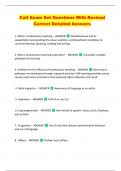Calt Exam Set Questions With Revised
Correct Detailed Answers
1. What is multisensory teaching - ANSWER Simultaneously and or
sequentially incorporating the visual, auditory, and kinesthetic modalities to
connect listening, speaking, reading and writing.
2. Why is multisensory teaching important? - ANSWER It provides multiple
pathways for learning
3. Evidence for the efficacy of multisensory teaching - ANSWER New neural
pathways are developed through repeated activities. MS teaching provides varied
sensory and motor activations that positively affect attention and recall.
4. Meta linguistics - ANSWER Awareness of language as an entity
5. Aspiration - ANSWER Puff of air /w/ /y/
6. Suprasegmentals - ANSWER the melody of speech- stress, pitch, loudness,
and so forth
7. Pragmatics - ANSWER Set of rules that dictate communicative behavior
and use of language
8. Affixes - ANSWER Prefixes and suffixes
,9. Dyspraxia - ANSWER Speech problems caused by sensorimotor disruption
10. Phonolgy - ANSWER Morphology, syntax, form of language
11. Dysarthria - ANSWER Speech problems caused by musculature
weaknesses
12. Schwa - ANSWER The sound "uh" made by the unaccented syllables in a
multi-syllabic word.
13. Semantics - ANSWER the set of rules by which we derive meaning from
morphemes, words, and sentences in a given language; also, the study of meaning
14. Phonetics - ANSWER Study of the characteristics of speech sound
15. Phonology - ANSWER The rules that deter in how sounds are used in
spoken language.
16. Allophone - ANSWER A variation of a speech sound and not a separate
phoneme
17. Phonological Awareness - ANSWER Awareness of speech sound or
phonemes in spoken words
,18. Alphabetic Principle - ANSWER the understanding that spoken sounds
are represented in print by written letters
19. Quartile - ANSWER A division of the alphabet that matches the four equal
divisions of the dictionary
20. Grapheme - ANSWER A letter or letter cluster that represents a single
speech sound.
Consonant - ANSWER A class of speech sounds with air flow that is
constricted or obstructed
Vowel - ANSWER a class of open speech sounds produced by the passage of
air through an open vocal tract
Rapid automatized naming (RAN - ANSWER The quick repeated naming of a
series of objects, colors, or letters in random order
Double deficit - ANSWER Deficit in phonological awareness and rapid naming
Guided discovery - ANSWER A method of leading students to new learning
through questioning
Phonemes: Vowels - ANSWER E, i, a, e, a, i, o, u, aw, o, o, o, u, er, ar, or,
oi/oy, ou/ow
, Phonemes: Consonant - ANSWER Blocked /f/, /hw/, /ks/, /l/, /r/, /s/, /sh/,
/th/, /v/, /w/, /z/, /zh/, /m/, /n/, /ng/
Partially: /b/, /d/, /ch/, /g/, /j/, /k/, /x/
Unblocked: /h/
Consonant Cognates - ANSWER Phonemes that have the same visually
display, mouth position and place of articulation but one sound activates the
vocal cords and one does not (Ex: /t/, /d/
Continuant Consonants - ANSWER Prolonged in their production (ex: /m/
Clipped Consonants - ANSWER Sounds are stopped and are obstructed at the
place of articulation (ex: /t/)
Nasals - ANSWER A sound produced by forcing air through the nose /m/, /n/
Stop - ANSWER A sound in which the outgoing air flow is completely
stopped. /t/, /k/
Fricative - ANSWER A sound produced by forcing air through a narrow
opening between the teeth and lops to make a hissing sound /f/, /z/
Afficate - ANSWER A consonant sound that consists of a slowly released stop
followed by a fricative /ch/, /j/
Glide - ANSWER Flowing and vowel-like /w/, /y/




